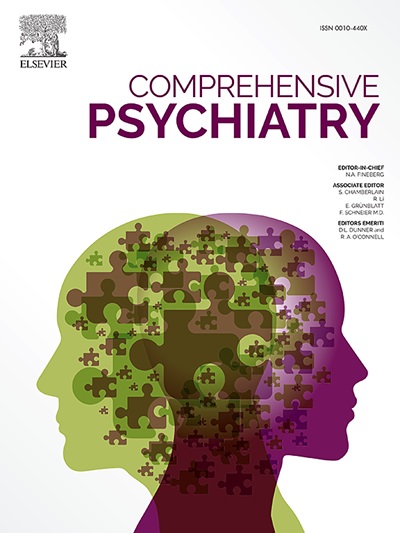异常前脑岛是精神分裂症患者述情障碍的内感受性缺陷的基础
IF 4.2
2区 医学
Q1 PSYCHIATRY
引用次数: 0
摘要
目的探讨精神分裂症合并述情障碍患者间感受异常的独特神经机制。重点是识别异常激活模式和脑岛皮层与参与情绪处理的区域的功能连接。方法采用多伦多述情障碍量表(TAS)和内感受意识多维度评估量表(MAIA)对50例精神分裂症患者进行评估。以任务为基础的功能磁共振成像(fMRI)扫描用于观察内感受状态下的大脑激活模式。结果与非述情障碍患者相比,述情障碍患者述情障碍程度较高,内感受程度较低。在内感受性任务中,述情障碍患者表现出前岛(AI)的激活减少,而后岛(PI)没有观察到差异。功能连通性分析显示,述情障碍患者的AI与前扣带皮层(ACC)以及额上回(SFG)之间的连通性降低。此外,AI和ACC之间的联系介导了内感受和述情障碍之间的关系。结论这些结果表明,述情精神分裂症患者难以将内感受性事件与情绪显著性相结合,并强调AI在述情精神分裂症患者的内感受性意识和情绪表达之间的相互作用中所起的作用,为有针对性的干预提供了潜在的神经生物学途径。试验注册:本研究已于2024年1月15日在中国临床试验注册中心(CCTR)注册,注册号为ChiCTR2400080313。本文章由计算机程序翻译,如有差异,请以英文原文为准。
Aberrant anterior insula underlies interoceptive deficits in alexithymia among schizophrenia patients
Objective
This study aims to investigate the unique neural mechanisms underpinning abnormal interoception in schizophrenia patients with comorbid alexithymia. The focus is on identifying aberrant activation patterns and functional connectivities of the insula cortex with regions involved in emotional processing.
Methods
Fifty schizophrenia patients were assessed using the Toronto Alexithymia Scale (TAS) and the Multidimensional Assessment of Interoceptive Awareness (MAIA). Task-based fMRI scans were conducted to observe brain activation patterns during interoceptive conditions.
Results
Alexithymic patients showed higher alexithymia and lower interoception compared to non-alexithymic patients. During the interoceptive task, alexithymic patients exhibited reduced activation in the anterior insula (AI), while no difference was observed in the posterior insula (PI). Functional connectivity analysis revealed reduced connectivity between the AI and the anterior cingulate cortex (ACC) as well as the superior frontal gyrus (SFG) in alexithymic patients. Moreover, the connection between the AI and the ACC mediated the relationship between interoception and alexithymia.
Conclusion
These results suggested that alexithymic schizophrenia patients struggle to integrate interoceptive afferents with emotional salience, and highlighted AI's role in the interplay between interoceptive awareness and emotional articulation in alexithymic schizophrenia, suggesting a potential neurobiological pathway for targeted interventions.
Trial registration: The research is registered with the China Clinical Trials Registry (CCTR), under the registration number ChiCTR2400080313 on January 15, 2024.
求助全文
通过发布文献求助,成功后即可免费获取论文全文。
去求助
来源期刊

Comprehensive psychiatry
医学-精神病学
CiteScore
12.50
自引率
1.40%
发文量
64
审稿时长
29 days
期刊介绍:
"Comprehensive Psychiatry" is an open access, peer-reviewed journal dedicated to the field of psychiatry and mental health. Its primary mission is to share the latest advancements in knowledge to enhance patient care and deepen the understanding of mental illnesses. The journal is supported by a diverse team of international editors and peer reviewers, ensuring the publication of high-quality research with a strong focus on clinical relevance and the implications for psychopathology.
"Comprehensive Psychiatry" encourages authors to present their research in an accessible manner, facilitating engagement with clinicians, policymakers, and the broader public. By embracing an open access policy, the journal aims to maximize the global impact of its content, making it readily available to a wide audience and fostering scientific collaboration and public awareness beyond the traditional academic community. This approach is designed to promote a more inclusive and informed dialogue on mental health, contributing to the overall progress in the field.
 求助内容:
求助内容: 应助结果提醒方式:
应助结果提醒方式:


